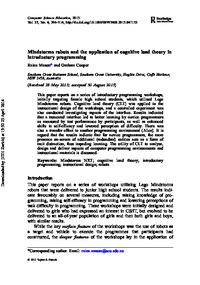Mindstorms robots and the application of cognitive load theory in introductory programmingRaina Mason, Graham Cooper
Publikationsdatum:
Zu finden in: Computer Science Education 4/2013 (Seite 296 bis 314), 2013
|
 |
 Diese Seite wurde seit 1 Jahr inhaltlich nicht mehr aktualisiert.
Unter Umständen ist sie nicht mehr aktuell.
Diese Seite wurde seit 1 Jahr inhaltlich nicht mehr aktualisiert.
Unter Umständen ist sie nicht mehr aktuell.
 Zusammenfassungen
Zusammenfassungen
This paper reports on a series of introductory programming workshops, initially targeting female high school students, which utilised Lego Mindstorms robots. Cognitive load theory (CLT) was applied to the instructional design of the workshops, and a controlled experiment was also conducted investigating aspects of the interface. Results indicated that a truncated interface led to better learning by novice programmers as measured by test performance by participants, as well as enhanced shifts in self-efficacy and lowered perception of difficulty. There was also a transfer effect to another programming environment (Alice). It is argued that the results indicate that for novice programmers, the mere presence on-screen of additional (redundant) entities acts as a form of tacit distraction, thus impeding learning. The utility of CLT to analyse, design and deliver aspects of computer programming environments and instructional materials is discussed.
Von Raina Mason, Graham Cooper im Journal Computer Science Education 4/2013 im Text Mindstorms robots and the application of cognitive load theory in introductory programming (2013)  Dieser wissenschaftliche Zeitschriftenartikel erwähnt ...
Dieser wissenschaftliche Zeitschriftenartikel erwähnt ...
 Begriffe KB IB clear | cognitive load theory (CLT)
,  LEGO Mindstorms
, LEGO Mindstorms
,  Lernen Lernen learning
, learning
,  Programmieren Programmieren programming
, programming
,  Schule Schule school school
|
 Dieser wissenschaftliche Zeitschriftenartikel erwähnt vermutlich nicht ...
Dieser wissenschaftliche Zeitschriftenartikel erwähnt vermutlich nicht ... 
 Nicht erwähnte Begriffe | Bildung, Kinder, LehrerIn, Unterricht |
 Tagcloud
Tagcloud
 Anderswo finden
Anderswo finden
 Volltext dieses Dokuments
Volltext dieses Dokuments
 |  Mindstorms robots and the application of cognitive load theory in introductory programming: Artikel als Volltext ( Mindstorms robots and the application of cognitive load theory in introductory programming: Artikel als Volltext ( : :  , 205 kByte; , 205 kByte;  : :  2020-11-28) 2020-11-28) |
 Anderswo suchen
Anderswo suchen 
 Beat und dieser wissenschaftliche Zeitschriftenartikel
Beat und dieser wissenschaftliche Zeitschriftenartikel
Beat hat Dieser wissenschaftliche Zeitschriftenartikel während seiner Zeit am Institut für Medien und Schule (IMS) ins Biblionetz aufgenommen. Beat besitzt kein physisches, aber ein digitales Exemplar. Eine digitale Version ist auf dem Internet verfügbar (s.o.). Aufgrund der wenigen Einträge im Biblionetz scheint er es nicht wirklich gelesen zu haben. Es gibt bisher auch nur wenige Objekte im Biblionetz, die dieses Werk zitieren.










 Biblionetz-History
Biblionetz-History